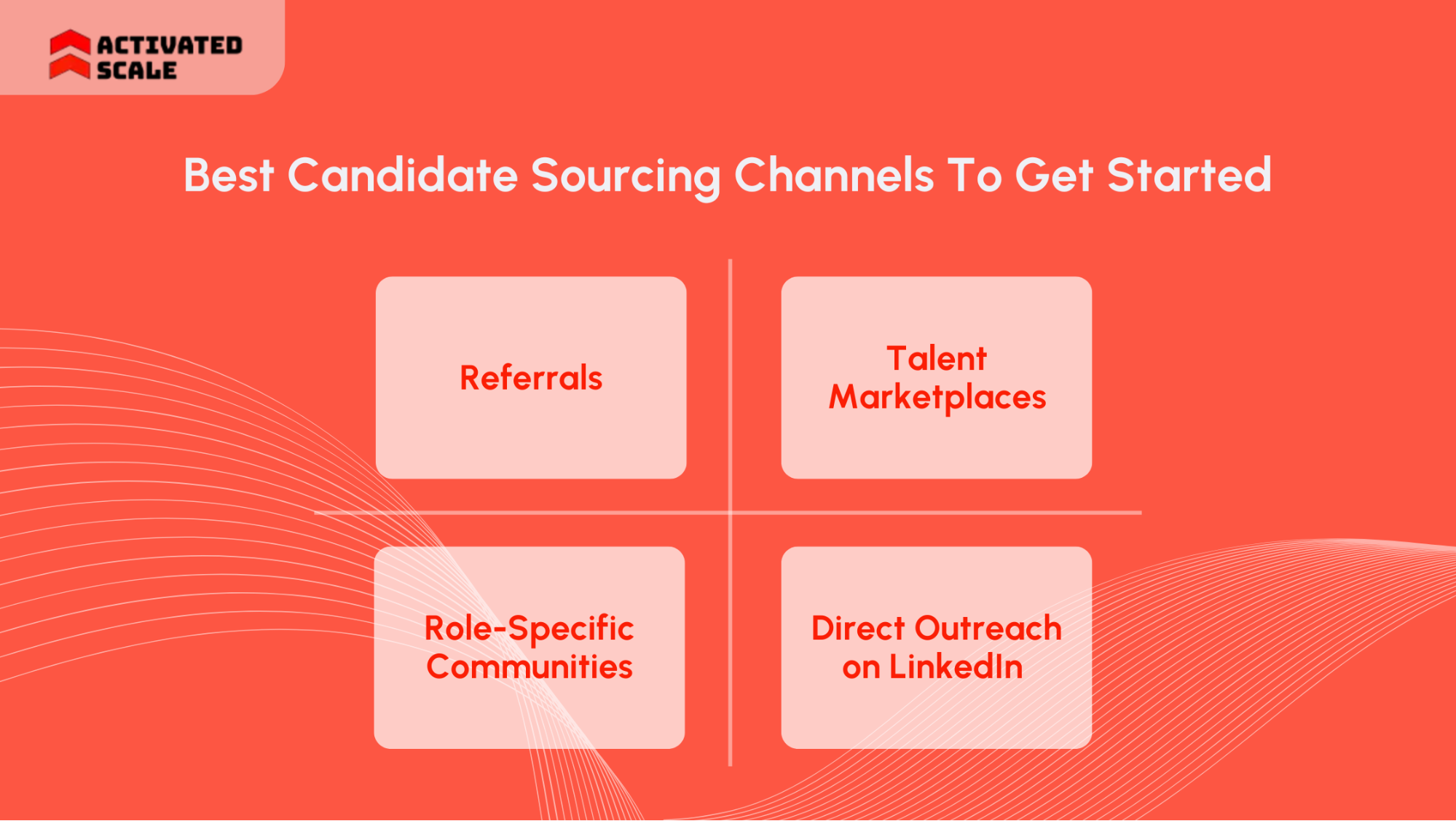Hiring top talent has become more complex, not because there aren’t enough candidates, but because the expectations for what “great talent” looks like have changed. Companies are going beyond resumes and job titles to look for people who can contribute immediately and adapt as the business grows. It’s why 76% of talent acquisition professionals now hire based on critical skills rather than formal qualifications, a shift that makes the hiring market more selective on both sides.
For founders and hiring managers, this means the old “post a job and hope the right people apply” approach no longer works. You need a clear structure, a sharp message about what your company offers, and a fair, consistent way to evaluate fit.
This blog will explain how to hire top talent with confidence, reduce early mis-hires, and build a team that drives long-term results.
Quick Overview
- Build a clear employer brand that shows what your company values and what candidates can expect from the role.
- Focus on skills, outcomes, and role clarity instead of relying only on past job titles or years of experience.
- Use sourcing channels that actually deliver: referrals, talent marketplaces, relevant communities, and thoughtful LinkedIn outreach.
- Keep candidates engaged with consistent communication and offer flexibility, growth paths, and wellness support.
- Use structured interviews and scoring rubrics to make fair decisions and hire the top talent with confidence.
How to Hire Top Talent: 7 Practical Steps

Hiring works best when the process is clear. These steps help your team define what good looks like, evaluate candidates consistently, and build a workplace people choose to stay in.
Step 1: Build a Clear and Appealing Employer Brand
People want to join companies where they understand the purpose, feel respected, and see opportunities to grow. If you want to hire top talent, your reputation and message need to reflect what makes your workplace meaningful. Your employer brand should answer: Why would someone choose to work here instead of somewhere else?
Key actions:
- Clarify mission and values in language that feels human, not corporate
- Highlight stories and outcomes from current team members
- Ensure job descriptions reflect responsibilities and work style accurately
Your brand should feel honest, relatable, and grounded in reality.
Also Check: Fractional Talent Guide: Everything You Need to Know.
Step 2: Prioritize Skills, Outcomes, and Role Clarity
Strong hiring starts with clarity. Candidates need to understand what the role looks like day-to-day and what success means within the first months. This transparency helps both sides determine fit early in the process.
Here’s what to define clearly:
- Core role responsibilities
- Must-have skills (not a long wish list)
- 30/60/90-day success outcomes
- Collaboration expectations: who they work with and how
People perform better when the path ahead is defined thoughtfully.
Step 3: Use AI and Data to Identify and Screen Candidates
AI tools can handle repetitive tasks like resume sorting and screening for keywords, freeing hiring teams to spend more time in meaningful conversations. But AI should serve as a filter, not the decision-maker.
Use technology for:
- Identifying patterns in work history
- Organizing candidate outreach and scheduling
- Reviewing screening questions or assessments
Keep the final evaluation based on structured conversations and work samples, not automation alone.
Step 4: Offer Work Flexibility That Matches Candidate Expectations
Flexibility continues to influence candidate decisions. It signals trust and supports productivity when implemented thoughtfully. Flexibility doesn’t always mean fully remote; it can simply mean offering reasonable control over how work gets done.
Ways to offer flexibility:
- Hybrid schedules or optional remote days
- Clear communication norms that prevent overwork
- Tools that support collaboration without constant meetings
Flexibility shows respect, and respect builds loyalty.
Step 5: Maintain Active, Ongoing Candidate Communication
Slow or unclear communication is one of the main reasons strong candidates disengage. Even small updates help candidates feel valued and informed.
Best practices:
- Share the interview process timeline at the start
- Keep communication consistent, even if there are delays
- Provide thoughtful feedback whenever possible
Responsiveness reflects reliability, and reliability strengthens your position as an employer.
Recommended: How Business Process Outsourcing Boosts Sales Strategy.
Step 6: Create a Supportive Growth and Wellness Culture
Top performers look for workplaces where they can grow without sacrificing their well-being. When development and wellness are visible priorities, retention improves naturally.
Show this through:
- Clear skill development plans
- Coaching or mentorship access
- Healthy workload expectations
- Recognition that celebrates meaningful contributions
People stay where they feel supported, not just employed.
Step 7: Use Structured and Consistent Hiring Processes
A structured hiring process ensures fairness and reduces guesswork. It also allows you to compare candidates based on evidence rather than personal preference.
Key elements include:
- Standard interview scorecards
- The same core questions across candidates
- Decisions made using shared criteria
- Review stages that prevent rushed hiring decisions
This approach helps you hire top talent reliably, because decisions are grounded in clarity, not intuition alone. If you’re hiring for sales roles, Activated Scale can strengthen this process by giving you a pool of vetted U.S.-based reps whose backgrounds and results are already well-documented, making structured evaluation quicker and more consistent.
Also, Check: How to Hire Effective Sales Leaders for Startups.
With the structure in place, the question becomes: where do you actually find strong candidates?
Best Candidate Sourcing Channels To Get Started

Job boards are crowded, inbound applications are unpredictable, and many skilled professionals aren’t actively applying to roles at all. The sourcing channels below tend to produce higher-quality candidates because they are built around trust, relevance, or direct connection, not volume.
1. Referrals
Referrals continue to be one of the most reliable ways to find strong talent. When someone recommends a candidate, they are effectively pre-vouching for work ethic, communication style, and integrity, qualities that are harder to evaluate from resumes alone.
How to make referrals effective:
- Be specific about the role and expectations so people refer to the right profiles
- Keep the referral process simple (no long forms)
- Follow up with referrers so they feel valued and informed
Referrals often lead to faster evaluations and stronger long-term retention.
2. Talent Marketplaces
Talent marketplaces give you access to candidates who are already vetted for skills, experience, and work reliability. Instead of starting from scratch, you begin with individuals who meet a baseline standard, which is especially valuable when the role needs to deliver impact quickly.
How to use talent marketplaces effectively:
- Choose general marketplaces for marketing, product, design, and operations roles
- Use specialized marketplaces when hiring for high-impact or harder-to-evaluate functions (e.g., sales)
- Review candidate portfolios, case studies, or deal histories before outreach
- Start with short-term or contract-to-hire engagements to confirm fit
For sales roles specifically, Activated Scale is a specialized marketplace that connects startups with U.S.-based SDRs, AEs, and fractional sales leaders who have proven GTM experience.
3. Role-Specific Communities and Slack Groups
Many strong candidates aren’t active on job boards but are active in professional communities where they share insights, ask questions, and exchange best practices.
Examples include:
- Paid Slack communities for SaaS sales professionals
- LinkedIn groups focused on B2B growth roles
- Niche industry circles formed around newsletters or podcasts
How to source here effectively:
- Participate naturally before posting job links
- Share value (tips, resources, small insights) first
- When posting roles, include role outcomes, not just duties
This approach builds trust, which leads to warmer, more thoughtful candidate conversations.
4. Direct Outreach on LinkedIn
LinkedIn outreach still works, but only when the message is thoughtful. Generic templates get ignored. Candidates want to know why they were chosen and what makes the role worth considering.
How to write outreach that gets replies:
- Mention a specific detail from their profile (recent work, a project, something shared)
- Keep the message short and human, not corporate
- Be clear about next steps (e.g., “20-minute intro conversation” instead of “interview”)
The goal of outreach is not to convince someone to take the job but to open a conversation.
Also Read: 25+ Effective Sales Team Building Strategies and Activities.
Furthermore, if one of the key roles you need to fill is in sales, the sourcing process can feel even more demanding. This is where a specialized partner can help.
Activated Scale: Your Partner for Hiring Proven Sales Talent
Activated Scale helps startups hire top-performing sales talent without long hiring cycles or guesswork. Instead of sorting through generic applicants, you connect directly with candidates who have already demonstrated success in early-stage GTM environments and selling to U.S. buyers.
Every candidate is pre-vetted for communication ability, quota performance, and cultural alignment. You can also begin with fractional or contract-to-hire arrangements to confirm fit before making a full-time decision.
What You Can Hire Through Activated Scale:
- Sales Development Representatives (SDRs): Focused on outbound prospecting, booking qualified meetings, and keeping the pipeline active so revenue activity doesn’t stall.
- Account Executives (AEs): Capable of running full-cycle sales: discovery, demos, negotiation, and closing, especially in founder-led or early GTM environments.
- Fractional VPs of Sales: Experienced leaders who can define GTM strategy, build repeatable playbooks, install sales processes, and coach early sales hires to success.
Want to see candidate profiles? Book a call with our team today.
Conclusion
Recruiting well comes down to having a clear process. When your message to candidates is consistent, your evaluation steps are defined, and your team knows what a strong hire looks like, the experience improves for everyone. It becomes easier to identify people who can contribute, grow, and stay.
If the role you’re hiring for is in sales, the stakes are higher because revenue impact is immediate. Activated Scale helps startups connect with pre-vetted, U.S.-based candidates who have experience working in early-stage environments. You can start on a fractional or contract-to-hire basis to confirm fit before making a long-term decision.
Get on a call with our team to get qualified sales talent today!
FAQ’s
1. How long does it realistically take to hire top talent?
Timelines vary by role, but most strong candidates move quickly. With a clear job scorecard, defined interview steps, and active sourcing, you can hire top talent in 3–6 weeks. Without structure, the process can stretch to several months.
2. What matters more, experience or skills?
Skills and outcomes matter more than years of experience. Focus on whether a candidate has done the specific work your role requires, in environments similar to yours. Use work samples or test tasks to validate ability.
3. How do we attract talent if we’re a smaller or lesser-known company?
Highlight mission clarity, impact of the role, and growth opportunities. Top performers value influence, autonomy, and meaningful work more than brand names alone.
4. How can we reduce bias in hiring decisions?
Use structured interviews, consistent evaluation criteria, and scoring rubrics. When everyone is assessed against the same expectations, decisions become fairer and more objective.
5. What if we need to hire quickly but don’t have time to run a full recruiting process?
Use referrals or talent marketplaces where professionals are already vetted. For sales roles specifically, Activated Scale connects startups with SDRs, AEs, and fractional sales leaders who can start contributing quickly.
The Ultimate Guide to Hiring a Salesperson!
Get the step-by-step guide to hiring, onboarding, and ensuring success!
_edi.png)




